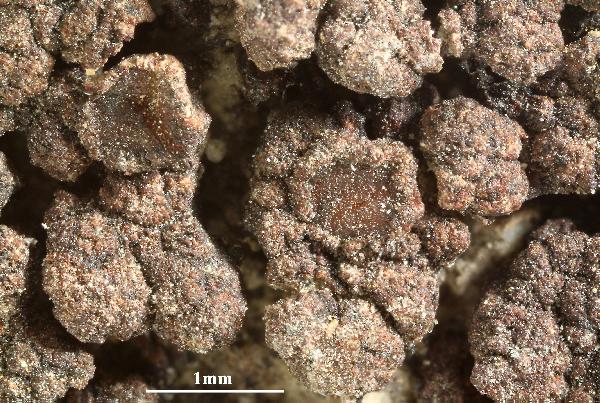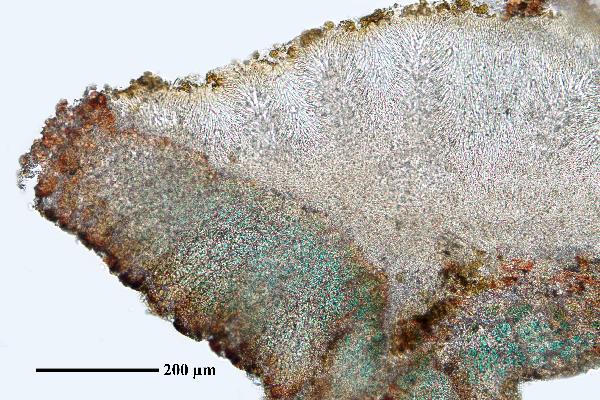Euopsis pulvinata (Schaer.) Vain.
Meddeland. Soc. Fauna Fl. Fenn., 6: 85, 1881. Basionym: Lecidea pulvinata Schaer. - Naturwiss. Anz., 2: 11, 1818.
Synonyms: Blennothallia haemalea (Sommerf.) Trevis.; Collema haemaleum Sommerf.; Pannaria haemalea (Sommerf.) A. Massal.; Pyrenopsis haemalea (Sommerf.) Norrl.; Pyrenopsis macrocarpa E. Dahl; Pyrenopsis pulvinata (Schaer.) Hellb.
Distribution: N - TAA (Nascimbene & al. 2022).
Description: Thallus subcrustose to small-squamulose, homoiomerous, subgelatinous when wet, ecorticate, uniformly dark reddish brown, to 0.3(-0.5) mm thick, forming up to 2 cm wide patches. Thallus anatomy paraplectenchymatous, the hyphae forming a large-celled network around the cyanobacteria. Apothecia formed in a tangle of generative hyphae, to 1 mm across, adnate, with a flat to convex, red-brown, often glossy disc, and a crenulate-squamulose thalline margin containing cyanobacteria. Thalline exciple c. 150 μm thick; proper exciple thin, 10-25 μm wide, of parallel hyphae; epithecium brownish; hymenium colourless, 100-150 μm high, I-, K/I-; paraphyses slender, sparingly branched, septate, gelatinized, not swollen at tips; hypothecium brownish, 70-90 μm high. Asci 8-spored, cylindrical, unitunicate, the wall composed of an outer, non-expansible and an inner, expansible layer surrounding the protoplast as an amyloid collar, which expands during spore release into a long, tapering rostrum, the outer wall layer strongly amyloid, its upper part separated from the expanded amyloid rostrum by a non-amyloid zone. Ascospores 1-celled, hyaline, ellipsoid, 9-15(-17) x (4-)5-8 μm. Pycnidia rare, immersed in warts. Conidia bacilliform, 4-5 x c. 1 μm. Photobiont cyanobacterial, chroococcoid (Gloeocapsa), surrounded by a reddish (in outer parts) to colourless (in inner parts) gelatinous sheath. Spot tests: thallus K-, C-, KC-, P-. Chemistry: without lichen substances.Note: a cool-temperate to boreal-montane, perhaps circumpolar lichen found on siliceous rocks, especially in seepage tracks on small pebbles in wet places, sometimes even on soil, usually in upland areas; much overlooked, and probably more widespread in the Alps.
Growth form: Crustose
Substrata: rocks
Photobiont: cyanobacteria, coccaceous (e.g. Gloeocapsa)
Reproductive strategy: mainly sexual
On otherwise dry surfaces with short periods of water seepage after rain
Commonnes-rarity: (info)
Alpine belt: extremely rare
Subalpine belt: very rare
Oromediterranean belt: absent
Montane belt: extremely rare
Submediterranean belt: absent
Padanian area: absent
Humid submediterranean belt: absent
Humid mediterranean belt: absent
Dry mediterranean belt: absent

Predictive model


Curtis Randall Björk – CC BY-SA 4.0
British Columbia, Boundary Ranges Date: 2013-07-02 On alpine cliff


Felix Schumm - CC BY-SA 4.0
[ABL56274], China, Yunnan Prov., Jianchuan Co., San Jiang Bin Liu
area, near mountain hotel, trailhead to Mt. Laojuenshan. Abies delavayi-
Rhododendron forest, on siliceous rock. 26°37’56’’ N, 99°43’30’’ E,
3900-4000 m. Leg. A. Aptroot (no 56274), 18.10.2002, det. A. Aptroot,
2003.


Felix Schumm - CC BY-SA 4.0
[ABL56274], China, Yunnan Prov., Jianchuan Co., San Jiang Bin Liu
area, near mountain hotel, trailhead to Mt. Laojuenshan. Abies delavayi-
Rhododendron forest, on siliceous rock. 26°37’56’’ N, 99°43’30’’ E,
3900-4000 m. Leg. A. Aptroot (no 56274), 18.10.2002, det. A. Aptroot,
2003.


Felix Schumm - CC BY-SA 4.0
[ABL56274], China, Yunnan Prov., Jianchuan Co., San Jiang Bin Liu
area, near mountain hotel, trailhead to Mt. Laojuenshan. Abies delavayi-
Rhododendron forest, on siliceous rock. 26°37’56’’ N, 99°43’30’’ E,
3900-4000 m. Leg. A. Aptroot (no 56274), 18.10.2002, det. A. Aptroot,
2003.


Felix Schumm - CC BY-SA 4.0
[ABL56274], China, Yunnan Prov., Jianchuan Co., San Jiang Bin Liu
area, near mountain hotel, trailhead to Mt. Laojuenshan. Abies delavayi-
Rhododendron forest, on siliceous rock. 26°37’56’’ N, 99°43’30’’ E,
3900-4000 m. Leg. A. Aptroot (no 56274), 18.10.2002, det. A. Aptroot,
2003.


Felix Schumm - CC BY-SA 4.0
[ABL56274], China, Yunnan Prov., Jianchuan Co., San Jiang Bin Liu
area, near mountain hotel, trailhead to Mt. Laojuenshan. Abies delavayi-
Rhododendron forest, on siliceous rock. 26°37’56’’ N, 99°43’30’’ E,
3900-4000 m. Leg. A. Aptroot (no 56274), 18.10.2002, det. A. Aptroot,
2003.


Felix Schumm - CC BY-SA 4.0
[ABL56274], China, Yunnan Prov., Jianchuan Co., San Jiang Bin Liu
area, near mountain hotel, trailhead to Mt. Laojuenshan. Abies delavayi-
Rhododendron forest, on siliceous rock. 26°37’56’’ N, 99°43’30’’ E,
3900-4000 m. Leg. A. Aptroot (no 56274), 18.10.2002, det. A. Aptroot,
2003.


Felix Schumm - CC BY-SA 4.0
[ABL56274], China, Yunnan Prov., Jianchuan Co., San Jiang Bin Liu
area, near mountain hotel, trailhead to Mt. Laojuenshan. Abies delavayi-
Rhododendron forest, on siliceous rock. 26°37’56’’ N, 99°43’30’’ E,
3900-4000 m. Leg. A. Aptroot (no 56274), 18.10.2002, det. A. Aptroot,
2003.


Felix Schumm - CC BY-SA 4.0
[ABL56274], China, Yunnan Prov., Jianchuan Co., San Jiang Bin Liu
area, near mountain hotel, trailhead to Mt. Laojuenshan. Abies delavayi-
Rhododendron forest, on siliceous rock. 26°37’56’’ N, 99°43’30’’ E,
3900-4000 m. Leg. A. Aptroot (no 56274), 18.10.2002, det. A. Aptroot,
2003.


Felix Schumm - CC BY-SA 4.0
[ABL56274], China, Yunnan Prov., Jianchuan Co., San Jiang Bin Liu
area, near mountain hotel, trailhead to Mt. Laojuenshan. Abies delavayi-
Rhododendron forest, on siliceous rock. 26°37’56’’ N, 99°43’30’’ E,
3900-4000 m. Leg. A. Aptroot (no 56274), 18.10.2002, det. A. Aptroot,
2003.


Felix Schumm - CC BY-SA 4.0
[ABL56274], China, Yunnan Prov., Jianchuan Co., San Jiang Bin Liu
area, near mountain hotel, trailhead to Mt. Laojuenshan. Abies delavayi-
Rhododendron forest, on siliceous rock. 26°37’56’’ N, 99°43’30’’ E,
3900-4000 m. Leg. A. Aptroot (no 56274), 18.10.2002, det. A. Aptroot,
2003.


Felix Schumm - CC BY-SA 4.0
[ABL56274], China, Yunnan Prov., Jianchuan Co., San Jiang Bin Liu
area, near mountain hotel, trailhead to Mt. Laojuenshan. Abies delavayi-
Rhododendron forest, on siliceous rock. 26°37’56’’ N, 99°43’30’’ E,
3900-4000 m. Leg. A. Aptroot (no 56274), 18.10.2002, det. A. Aptroot,
2003.
Growth form: Crustose
Substrata: rocks
Photobiont: cyanobacteria, coccaceous (e.g. Gloeocapsa)
Reproductive strategy: mainly sexual
On otherwise dry surfaces with short periods of water seepage after rain
Commonnes-rarity: (info)
Alpine belt: extremely rare
Subalpine belt: very rare
Oromediterranean belt: absent
Montane belt: extremely rare
Submediterranean belt: absent
Padanian area: absent
Humid submediterranean belt: absent
Humid mediterranean belt: absent
Dry mediterranean belt: absent

Predictive model


Curtis Randall Björk – CC BY-SA 4.0
British Columbia, Boundary Ranges Date: 2013-07-02 On alpine cliff


Felix Schumm - CC BY-SA 4.0
[ABL56274], China, Yunnan Prov., Jianchuan Co., San Jiang Bin Liu area, near mountain hotel, trailhead to Mt. Laojuenshan. Abies delavayi- Rhododendron forest, on siliceous rock. 26°37’56’’ N, 99°43’30’’ E, 3900-4000 m. Leg. A. Aptroot (no 56274), 18.10.2002, det. A. Aptroot, 2003.


Felix Schumm - CC BY-SA 4.0
[ABL56274], China, Yunnan Prov., Jianchuan Co., San Jiang Bin Liu area, near mountain hotel, trailhead to Mt. Laojuenshan. Abies delavayi- Rhododendron forest, on siliceous rock. 26°37’56’’ N, 99°43’30’’ E, 3900-4000 m. Leg. A. Aptroot (no 56274), 18.10.2002, det. A. Aptroot, 2003.


Felix Schumm - CC BY-SA 4.0
[ABL56274], China, Yunnan Prov., Jianchuan Co., San Jiang Bin Liu area, near mountain hotel, trailhead to Mt. Laojuenshan. Abies delavayi- Rhododendron forest, on siliceous rock. 26°37’56’’ N, 99°43’30’’ E, 3900-4000 m. Leg. A. Aptroot (no 56274), 18.10.2002, det. A. Aptroot, 2003.


Felix Schumm - CC BY-SA 4.0
[ABL56274], China, Yunnan Prov., Jianchuan Co., San Jiang Bin Liu area, near mountain hotel, trailhead to Mt. Laojuenshan. Abies delavayi- Rhododendron forest, on siliceous rock. 26°37’56’’ N, 99°43’30’’ E, 3900-4000 m. Leg. A. Aptroot (no 56274), 18.10.2002, det. A. Aptroot, 2003.


Felix Schumm - CC BY-SA 4.0
[ABL56274], China, Yunnan Prov., Jianchuan Co., San Jiang Bin Liu area, near mountain hotel, trailhead to Mt. Laojuenshan. Abies delavayi- Rhododendron forest, on siliceous rock. 26°37’56’’ N, 99°43’30’’ E, 3900-4000 m. Leg. A. Aptroot (no 56274), 18.10.2002, det. A. Aptroot, 2003.


Felix Schumm - CC BY-SA 4.0
[ABL56274], China, Yunnan Prov., Jianchuan Co., San Jiang Bin Liu area, near mountain hotel, trailhead to Mt. Laojuenshan. Abies delavayi- Rhododendron forest, on siliceous rock. 26°37’56’’ N, 99°43’30’’ E, 3900-4000 m. Leg. A. Aptroot (no 56274), 18.10.2002, det. A. Aptroot, 2003.


Felix Schumm - CC BY-SA 4.0
[ABL56274], China, Yunnan Prov., Jianchuan Co., San Jiang Bin Liu area, near mountain hotel, trailhead to Mt. Laojuenshan. Abies delavayi- Rhododendron forest, on siliceous rock. 26°37’56’’ N, 99°43’30’’ E, 3900-4000 m. Leg. A. Aptroot (no 56274), 18.10.2002, det. A. Aptroot, 2003.


Felix Schumm - CC BY-SA 4.0
[ABL56274], China, Yunnan Prov., Jianchuan Co., San Jiang Bin Liu area, near mountain hotel, trailhead to Mt. Laojuenshan. Abies delavayi- Rhododendron forest, on siliceous rock. 26°37’56’’ N, 99°43’30’’ E, 3900-4000 m. Leg. A. Aptroot (no 56274), 18.10.2002, det. A. Aptroot, 2003.


Felix Schumm - CC BY-SA 4.0
[ABL56274], China, Yunnan Prov., Jianchuan Co., San Jiang Bin Liu area, near mountain hotel, trailhead to Mt. Laojuenshan. Abies delavayi- Rhododendron forest, on siliceous rock. 26°37’56’’ N, 99°43’30’’ E, 3900-4000 m. Leg. A. Aptroot (no 56274), 18.10.2002, det. A. Aptroot, 2003.


Felix Schumm - CC BY-SA 4.0
[ABL56274], China, Yunnan Prov., Jianchuan Co., San Jiang Bin Liu area, near mountain hotel, trailhead to Mt. Laojuenshan. Abies delavayi- Rhododendron forest, on siliceous rock. 26°37’56’’ N, 99°43’30’’ E, 3900-4000 m. Leg. A. Aptroot (no 56274), 18.10.2002, det. A. Aptroot, 2003.


 Index Fungorum
Index Fungorum
 GBIF
GBIF


